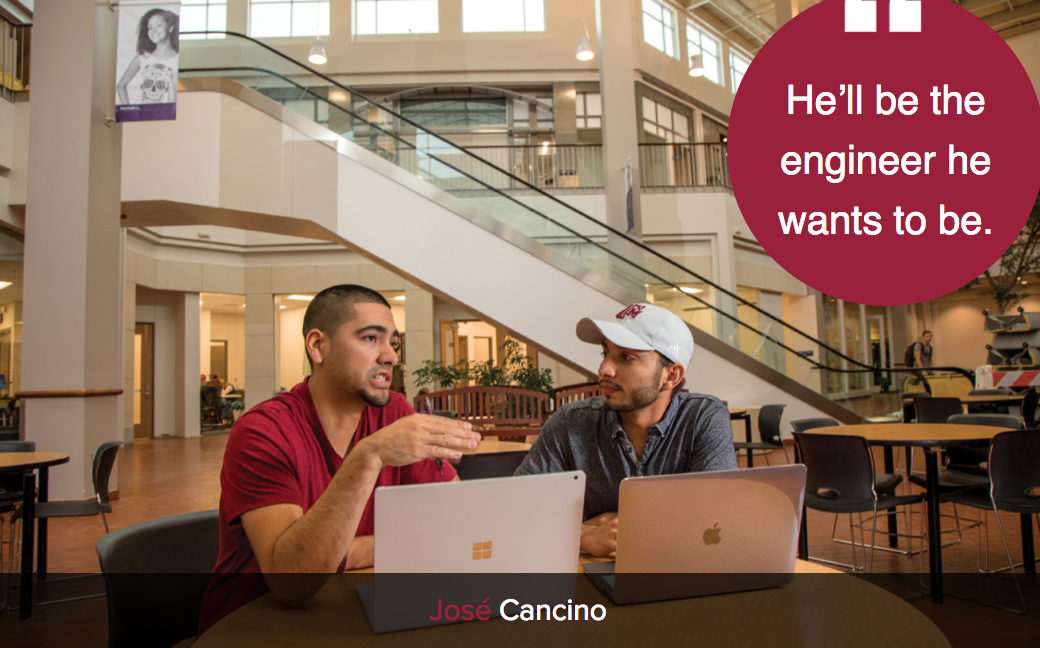Lumina Focus: José Cancino | Once a Dropout, Now a Scholar
 ONCE A DROPOUT, NOW A SCHOLAR
ONCE A DROPOUT, NOW A SCHOLAR
AUSTIN, Texas — Sometimes it just takes a change of scene to change a life. Just ask José Cancino.
In 2015, Cancino was a high school dropout doing odd jobs in carpentry and landscaping in suburban Chicago when his mother got a new job in Austin, Texas. Now, 18 months later, he’s preparing to earn an associate degree at Austin Community College and advance to the engineering program at Texas A&M University in 2018.
“I never thought I’d be pursuing an engineering degree. My family can’t believe it either,” Cancino said. “My family back in Chicago can’t believe it either. Everyone is pretty excited.”

Cancino works on the ACC campus with Shana Shaw, an associate professor in Texas A&M’s engineering school. As a student in the Texas A&M Chevron Technology Academy, Cancino is on track to earn a guaranteed spot in the engineering program at A&M.
Now 26, Cancino left Waukegan High School in suburban Chicago without finishing. His parents made it clear that if he wasn’t going to school, he needed to work. So Cancino spent six years working in restaurant kitchens and taking carpentry and landscaping jobs.
“I was a teen-ager back then. I knew everything,” he said, remembering his first years out of high school.
“I guess it was rebellion or whatever.”
He also admits he “wasn’t hanging out with a good crowd.”
“I wasn’t happy, but I was complacent,” he said. “If I had stayed in Chicago, I wouldn’t be doing what I’m doing today. It (the move) got me away from everybody.”
He had started classes at College of Lake County in the fall of 2015 — just before his mother got a job as a systems analyst at a firm near Austin and the family decided to move south. Once in Texas, Cancino began to re-evaluate his priorities, particularly in light of his experience as a landscape worker.
“When I moved here, I took a look at my life and said, ‘Do I want to work at jobs like this until I’m 40?’” he said. “Texas is pretty hot, so I sure didn’t want to work in the sun.”
He learned about Austin Community College and enrolled in courses to complete his GED, which he finished in 2016. He then started working toward an associate degree, going slowly at first because he had to pay out-of-state tuition. He took a job at a grocery, and the pay stubs he saved over a year of work helped him prove his Texas residency.

David Fonken, dean of mathematics and science at Austin Community College, has high hopes for Cancino – and plenty of confidence in him. “He’s on track now,” Fonken says. “All he needs to do now is do the work, and he’ll be the engineer he wants to be.”
With in-state tuition, the cost of each class dropped from $1,200 to $360, which he covers with the help of a Pell grant, an Austin Community College scholarship and another scholarship he received because he proceeded straight to college after earning his GED.
Then, he learned about a program new to Austin Community College. Starting this fall, the Austin college has joined other schools in the Texas A&M Chevron Technology Academy. Students accepted into the program at the community college level work toward their associate degrees while also taking introductory engineering courses taught by Texas A&M faculty. If they finish the program in good standing, they are guaranteed a spot in the A&M engineering program at the College Station campus.
The program thus offers students a clear path to A&M and a way to save thousands of dollars by getting their first two years of training at a community college, said David Fonken, dean of mathematics and science at Austin Community College.
“He’s on track now,” Fonken said of Cancino. “All he needs to do now is do the work, and he’ll be the engineer he wants to be.”
Cancino remains surprised by his good fortune. The admissions process for the program was competitive, he said. And at the time he applied, he had only four credit courses on his transcript. In addition to filling out the basic application and submitting his transcript, he had to write three essays — one on why he chose the program, another on his career and life goals, and a third to explain his interest in engineering.
“I just told them I wanted to be the best individual I could be,” he said. “I also told them I want to change the automobile industry” by making vehicles more environmentally friendly and improving self-driving technology.
Cancino is taking 13 credit hours, including the A&M engineering course, while working up to 20 hours a week at a grocery. His goal is to finish the ACC program in 2018 and begin studying at Texas A&M in 2018.
He knows it’ll take hard work and likely some financial assistance for him to make the grade at A&M. But he’s committed to giving his best effort, and he said the people at Austin Community College are committed to seeing him and his 67 colleagues in the engineering program succeed.
“I’m hanging in there,” Cancino said. “It’s difficult taking a full schedule of classes, and this engineering course is kicking my butt.
“The people here are very friendly, and they work with you,” he said. “They want people to get a certificate or degree or transfer to another institution. But it’s up to the individual.”
Tags: David Fonken, Dwight Look College of Engineering, engineering, José Cancino, Lumina Focus, Shana Shaw, Texas A&M University
Back to Top
